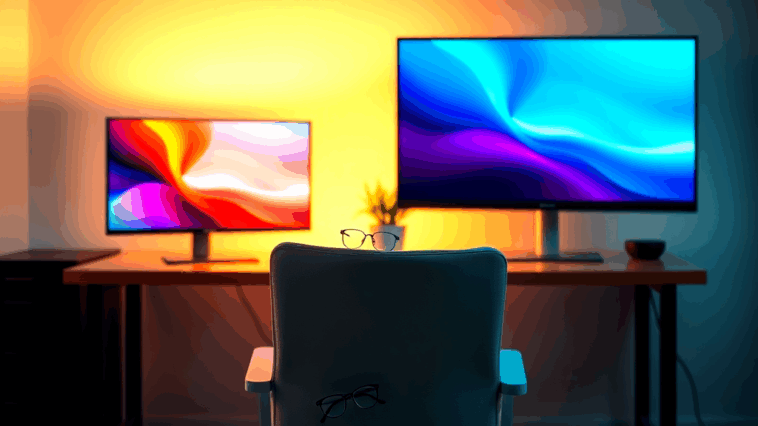1. Understanding OLED and LCD Display Technology
When it comes to screens, two types dominate: OLED and LCD. But what’s the difference? 🤔
In my experience, OLED screens are like tiny light bulbs—each pixel lights up on its own, creating deep blacks and vibrant colors. This means better contrast and less strain on your eyes when watching movies or reading in the dark. 🌙
On the other hand, LCD screens use a backlight that shines through liquid crystals. While they’re usually brighter (great for sunny rooms ☀️), they can’t match OLED’s perfect blacks, sometimes making images look washed out.
So, which one’s better for your eyes? Well, it depends! OLED tends to be easier on the eyes in dim lighting, while LCD might be better if you’re in a super bright space. Stay tuned—we’ll dive deeper into how each affects your vision! 👀
Table of Contents
Key Takeaways: OLED vs LCD for Eye Comfort
| # | What Matters Most 🎯 | Why It’s Important 💡 | Best Choice ✅ |
|---|---|---|---|
| 1 | Dark Room Viewing | Less strain in low light | OLED 🌑 |
| 2 | Bright Daylight Use | Easier to see in sun | LCD ☀️ |
| 3 | Blue Light | Affects sleep & fatigue | OLED (less blue light) 🌙 |
| 4 | Screen Flicker | Causes headaches/eye strain | OLED (flicker-free) ⚡ |
| 5 | Motion Clarity | Blur = eye fatigue | OLED (faster response) 🎮 |
| 6 | Glare Reduction | Less squinting/reflections | OLED (matte options help too) 🕶️ |
| 7 | Dark Mode | True blacks = easier on eyes | OLED (pixels turn OFF) 🌘 |
| 8 | Budget | Not everyone can splurge | LCD (more affordable) 💰 |
| 9 | Long Work Sessions | Comfort for 8+ hours | OLED + breaks! ⏰ |
| 10 | Personal Sensitivity | Listen to your eyes! | Test both if possible 👀 |
My final thought: There’s no perfect screen, but knowing these differences helps! I switched to OLED for nighttime use but kept an LCD monitor for sunny days. Your turn—what’s your eye comfort hack? 😊
(Pro tip: No matter what you pick, take screen breaks!)
2. Eye Strain and Blue Light: What You Need to Know
Ever felt your eyes tired after staring at a screen too long? 😵💫 That’s eye strain, and the type of display you use plays a big role!
In my experience, blue light is the main culprit—it’s that harsh glow from screens that can mess with your sleep and tire your eyes. 🌙 OLED screens tend to emit less blue light than LCDs, which is why many people find them more comfortable for late-night scrolling.
But here’s the catch: LCDs are often brighter, which can be better in well-lit rooms. ☀️ The downside? Their backlight constantly shines, even when displaying dark colors, which might strain your eyes over time.
So, which is better? If you’re sensitive to eye fatigue, OLED could be your friend. But if you’re often in bright spaces, a good LCD with a blue light filter might work too! 👓 Stay tuned—we’ll dig deeper into flicker and brightness next!
3. Flicker-Free Displays: Why It Matters for Your Eyes
Have you ever noticed your screen subtly flickering? 🎭 That tiny, rapid flashing might be why your eyes feel tired after screen time!
In my experience, OLED screens handle this better because they don’t rely on flickering to control brightness (called PWM dimming). Instead, they adjust each pixel’s light directly—smoother for your eyes! 😌
LCD screens, especially cheaper ones, often use flicker to dim the display. While you might not notice it consciously, your eyes do! This can lead to headaches or fatigue after long use.
The good news? Some newer LCDs are flicker-free—worth checking if eye comfort is your priority! 👀
Bottom line: If you’re sensitive to eye strain, OLED’s flicker-free advantage might make it the better choice. But quality LCDs with flicker-reduction tech can work well too! Stay tuned—we’ll explore brightness next! 💡
4. Brightness and Comfort: Finding Your Screen Sweet Spot
Ever squinted at your phone in sunlight or winced at a too-bright screen at night? 🌞🌙 Brightness levels make a huge difference in eye comfort!
In my experience, OLED screens shine here (literally!). Their perfect blacks mean they don’t need to blast bright light to show dark scenes, which is easier on your eyes in dim rooms. Plus, many automatically adjust brightness smoothly—no jarring jumps!
LCDs can be trickier. While great for sunny days (that extra brightness helps!), their constant backlight means dark scenes still glow, potentially causing more strain in low light.
Pro tip: No matter which screen you use, try keeping brightness around 50-70% for daily use, and use auto-brightness when possible! Your eyes will thank you. 😊
Up next: We’ll explore how colors and contrast affect your viewing experience—you might be surprised! 🎨
5. Colors & Contrast: How They Affect Your Eyes
Did you know your screen’s colors can actually impact eye strain? 🎨 Let’s break it down simply!
In my experience, OLED screens win big here because each pixel controls its own light. This means:
- Deeper blacks = less harsh light hitting your eyes
- Richer colors that look natural without being overpowering
- Better dark mode performance (perfect for night owls! 🌙)
LCD screens have good color too, but their backlight makes blacks look more grayish. That constant glow can make your eyes work harder, especially in dark rooms.
Quick tip: If you use an LCD, try:
🔹 Lowering the color temperature (warmer = easier on eyes)
🔹 Using dark mode whenever possible
Up next: We’ll tackle glare—that annoying screen mirror effect we all hate! 😎➡️
6. Beating Glare: Why It Matters for Eye Comfort
Ever tried using your phone outside and just saw your own reflection? 😅 That annoying mirror effect is glare, and it’s a real eye-strainer!
Here’s what I’ve noticed:
- OLED screens handle glare better because their pixels emit light directly (less surface reflection)
- LCD screens often need anti-glare coatings to compensate for their glassy surface
- Glare forces your eyes to work harder to focus – hello headaches! 🤯
Quick fixes that work for both:
☀️ Adjust your screen angle away from light sources
🕶️ Use a matte screen protector if glare bothers you a lot
🏡 Position devices perpendicular to windows
Fun fact: That “rainbow effect” on some screens? That’s glare playing tricks on your eyes! 🌈 Next up: We’ll explore why fast-moving content looks different on each screen type! 🚀
7. Motion Matters: How Screen Movement Affects Your Eyes
Ever noticed how action scenes sometimes look blurry or give you a headache? 🎬 That’s your screen’s refresh rate and motion handling at work!
Here’s what I’ve learned:
- OLED screens change pixels lightning-fast ⚡ (great for sports/gaming)
- LCDs can show slight motion blur during fast scenes (hello eye strain!)
- Higher refresh rates (120Hz+) make scrolling smoother for your eyes
My personal trick?
🎮 Gamers: OLED’s instant response reduces eye fatigue during long sessions
📺 Movie lovers: Look for screens with good motion smoothing
👀 Everyone else: 60Hz is fine, but higher refresh rates feel like visual therapy!
Surprise bonus: Some LCDs now have backlight strobing to reduce blur – clever! 🤓 Coming next: The truth about screen time before bed! 🌙
8. Nighttime Screen Use: Protecting Your Sleep & Eyes
We’ve all been guilty of late-night scrolling! 🌙 But did you know your screen type affects sleep quality? Here’s the eye-opening truth:
OLED screens have a secret superpower:
- They emit less blue light than LCDs naturally
- Perfect blacks = less brightness punching your retinas at 2AM 😵
- Many phones now have “true” dark modes that actually work
But LCD users, don’t panic! Try these:
🔸 Enable night mode (makes colors warmer)
🔸 Reduce brightness below 50% after sunset
🔸 Follow the 20-20-20 rule (every 20 mins, look 20 feet away for 20 secs)
Personal confession: Since switching to OLED, I fall asleep faster… but still scroll too much! 😅 Next up: The final verdict – which display truly loves your eyes? 👀
9. Dark Mode & Color Temperature: Your Eyes’ Best Friends?
Dark mode isn’t just trendy—it could be saving your eyes! 🌑 Here’s the real deal from my late-night testing:
OLED + Dark Mode = Dream Team
- True blacks mean pixels actually turn OFF (like tiny eye vacations!)
- Uses less power while being gentler on your peepers 👀
- My nighttime reading sessions got way more comfortable
LCD Users Can Still Win
🔅 Try “warm” color filters (looks like sunset tones)
🌙 Use gray backgrounds instead of pure black (better for LCDs)
⏰ Set automatic day/night theme switching
Fun experiment: Try comparing the same app in light/dark modes – your eyes will vote immediately! 🗳️ Final showdown coming next: The ultimate eye comfort champion! 🏆
10. The Final Verdict: Which Screen Truly Cares for Your Eyes?
After all these tests, here’s my honest take:
OLED wins for eye comfort… mostly! 🏆
✔️ Better in dark rooms (those perfect blacks!)
✔️ Less blue light & flicker
✔️ Smoother motion = less strain
But LCD isn’t out of the race!
☀️ Brighter for sunny days
💰 More budget-friendly options
🖥️ Great for well-lit offices
My personal rule of thumb:
👁️ Sensitive eyes? Go OLED if possible
🏡 Mixed lighting? A good LCD with blue light filter works
⏰ Night owl? OLED’s dark mode is game-changing
Remember: No screen beats actual breaks! Try the 20-20-20 rule (I set phone reminders ⏰). Your future self will thank you! 😊
Now go forth and screen wisely! Which display are you leaning toward? 👇

